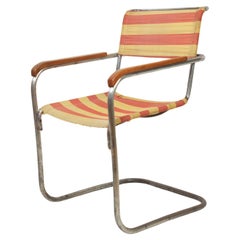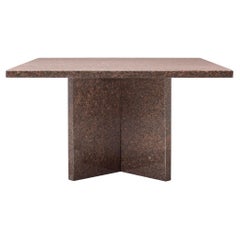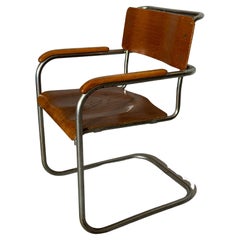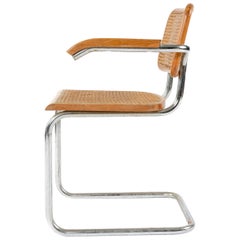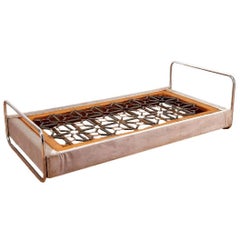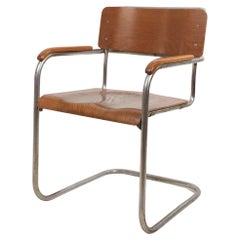Vintage Marcel Breuer
to
250
1,953
1,122
3,149
1,591
1,326
768
418
389
384
198
53
51
1,513
251
246
135
53
Sort By
Marcel Breuer B34 Chair 1930s
By Marcel Breuer
Located in Čelinac, BA
Marcel Breuer B34 Chair 1930s
Category
1930s Austrian Bauhaus Vintage Marcel Breuer
Materials
Chrome
Marcel Breuer Custom Dining Table from the Offices of Marcel Breuer, New York
By Marcel Breuer
Located in Chicago, IL
Marcel Breuer Custom Dining Table from the Offices of Marcel Breuer, New York 1965
A striking
Category
1960s Indian Mid-Century Modern Vintage Marcel Breuer
Materials
Granite
$19,200 Sale Price
20% Off
H 29.25 in W 52 in D 52 in
Wassily chair by Marcel Breuer
By Marcel Breuer
Located in Banská Štiavnica, SK
Wassily chair by Marcel Breuer later production from 1970s. New fabric seat.
Category
1970s German Bauhaus Vintage Marcel Breuer
Materials
Stainless Steel
Marcel Breuer b34 Chair 1930s
By Marcel Breuer
Located in Čelinac, BA
Marcel Breuer B34 chair was made in Czechoslovakia in 1930 for Bata Snofmaner store.
Category
Mid-20th Century Post-Modern Vintage Marcel Breuer
Materials
Formica
Cesca Armchair by Marcel Breuer, 1928
By Marcel Breuer
Located in Sagaponack, NY
A minimal Cesca armchair designed by Marcel Breuer featuring caned seat and back on a cantilevered
Category
1930s American Mid-Century Modern Vintage Marcel Breuer
Materials
Metal
Marcel Breuer Style Daybed
By Marcel Breuer
Located in Los Angeles, CA
Amazing Marcel Breuer style daybed. Tubular chrome at both ends. Bed has hinges which allow it to
Category
1940s Austrian Vintage Marcel Breuer
Materials
Chrome
Marcel Breuer B34 Tubular Armchair 1930s
By Marcel Breuer
Located in Čelinac, BA
Marcel Breuer B34 Armchair 1930s
Category
1930s Austrian Bauhaus Vintage Marcel Breuer
Materials
Chrome
Wassily Armchairs by Marcel Breuer
By Marcel Breuer
Located in Austin, TX
Armchair, Italian, produced by Gavina. This B3 armchair by Marcel Breuer features a bent chromed
Category
1970s Italian Modern Vintage Marcel Breuer
Materials
Steel
Marcel Breuer Cesca Chair Italy 1970s
By Marcel Breuer
Located in Čelinac, BA
Marcel Breuer Cesca Chair Italy 1970s
Category
1970s Italian Mid-Century Modern Vintage Marcel Breuer
Materials
Chrome
Marcel Breuer Candle Stick for Gavina
By Marcel Breuer
Located in New York, NY
Nickel Plated Steel Candlestick by Marcel Breuer for Gavina. These were originally made as gifts by
Category
20th Century Italian Modern Vintage Marcel Breuer
Materials
Steel, Nickel
Marcel Breuer Wassily Lounge Chair by Gavina
By Marcel Breuer
Located in Vilnius, LT
Vintage Wassily lounge chair, designed by Marcel Breuer, circa 1925.
Stamped signature of Marcel
Category
Mid-20th Century Italian Mid-Century Modern Vintage Marcel Breuer
Materials
Chrome
$2,429 Sale Price
30% Off
H 28.75 in W 31.11 in D 27.17 in
Marcel Breuer Pair of 'B64' Armchairs
By Marcel Breuer
Located in London, GB
Pair of Marcel Breuer 'B64' armchairs, circa 1960s.
Dimensions: H82 x W60 x D55 cm.
Category
20th Century Hungarian Mid-Century Modern Vintage Marcel Breuer
Materials
Cane
Marcel Breuer Tubular-Steel B10 Table
By Marcel Breuer
Located in New York, NY
Marcel Breuer tubular-steel B10 table chrome-plated tubular frame table with a black smoked glass
Category
1930s German Modern Vintage Marcel Breuer
Materials
Chrome
Marcel Breuer Cesca Chair for THONET 1978
By Marcel Breuer
Located in Čelinac, BA
Marcel Breuer Cesca Chair 1978
Category
1970s Austrian Mid-Century Modern Vintage Marcel Breuer
Materials
Chrome
CESCA Chair By Marcel Breuer Italy 1970s
By Marcel Breuer
Located in Čelinac, BA
Cesca Chair By Marcel Breuer Italy 1970s
Category
1970s Italian Mid-Century Modern Vintage Marcel Breuer
Materials
Chrome
Italian Cesca Chair 1952 After Marcel Breuer
By Marcel Breuer
Located in Čelinac, BA
Marcel Breuer Cesca Chair Italy 1952
Category
1950s Italian Mid-Century Modern Vintage Marcel Breuer
Materials
Chrome
Marcel Breuer’s Wassily Design Style Armchair
By Marcel Breuer
Located in Austin, TX
Armchair in the manner of Marcel Breuer’s famous Wassily design. This chair is made of white
Category
1960s French Mid-Century Modern Vintage Marcel Breuer
Materials
Steel, Chrome
Cesca Chair After Marcel Breuer Italy 1960s
By Marcel Breuer
Located in Čelinac, BA
After Marcel Breuer Cesca Chair Italy 1960s
Category
1960s Italian Mid-Century Modern Vintage Marcel Breuer
Materials
Chrome
B3 Wassily Chair by Marcel Breuer
By Marcel Breuer
Located in Miami, FL
B3 wassily chair by marcel breuer for gavina, italy 1960’s
The Wassily Lounge Chair was designed
Category
Mid-20th Century Italian Bauhaus Vintage Marcel Breuer
Materials
Steel, Chrome
Desk by Marcel Breuer, 1955
By Marcel Breuer, Gavina
Located in Berlin, DE
cm H.72.5 cm
Design: Marcel Breuer, 1955
Manufacturer: Gavina, Italy
cf. V. Vercelloni, Das Abenteuer
Category
1950s Italian Mid-Century Modern Vintage Marcel Breuer
Materials
Wood
Marcel Breuer Cesca Chair, circa 1980
By Marcel Breuer
Located in Barcelona, Barcelona
Chair, model Cesca, designed by Marcel Breuer around 1970, manufactured in Italy.
Metal pipe frame
Category
1980s Italian Mid-Century Modern Vintage Marcel Breuer
Materials
Chrome
Marcel Breuer Isokon Loung Chair
By Marcel Breuer
Located in Oosterbeek, NL
Marcel Breuer famously designed innovative wood bent furniture before his metal tubular designs
Category
1930s English Mid-Century Modern Vintage Marcel Breuer
Materials
Plywood
Marcel Breuer Cantilever Chair, circa 1960
By Marcel Breuer
Located in Barcelona, Barcelona
Chair model cantilever, designed by Marcel Breuer circa 1960, by unknown manufacturer.
Metal pipe
Category
1960s European Mid-Century Modern Vintage Marcel Breuer
Materials
Metal
Marcel Breuer, Daybed, Steel, Fabric, Hungary, c. 1940
By Marcel Breuer
Located in High Point, NC
A steel and fabric daybed, by Marcel Breuer, Hungary, c. 1940.
Provenance
Gift of Miani Johnson
Category
1940s Hungarian Mid-Century Modern Vintage Marcel Breuer
Materials
Steel
Vintage Daybed "Wassily" by Marcel Breuer - 1970s
By Marcel Breuer
Located in Roma, IT
Daybed designed by Marcel Breuer in 1920s, realized in tubular chromed metal frame and leather
Category
1970s Vintage Marcel Breuer
Materials
Metal
Wicker armchair Marcel Breuer style 1970s Italy
By Marcel Breuer
Located in Den Haag, NL
Very nice armchair . In the style of Marcel Breuer . Wicker seat
and back rest .Good seating
Category
1970s Italian Mid-Century Modern Vintage Marcel Breuer
Materials
Wicker
Marcel Breuer Prototype Beds, 1935
By Marcel Breuer
Located in London, GB
A pair of columbian pine prototype single beds designed by Marcel Breuer in 1935.
Produced by P.E
Category
1930s Modern Vintage Marcel Breuer
Materials
Pine
Black Cesca Chair After Marcel Breuer Italy 1980s
By Marcel Breuer
Located in Čelinac, BA
Cesca Chair After Marcel Breuer Italy 1980s
Category
1980s Italian Mid-Century Modern Vintage Marcel Breuer
Materials
Metal
Black Cesca Chair Affter Marcel Breuer Italy 1980s
By Marcel Breuer
Located in Čelinac, BA
Style of Marcel Breuer Black Cesca Chair Italy 1980s
Category
1980s Italian Mid-Century Modern Vintage Marcel Breuer
Materials
Metal
Tubular Steel Table B 9 by Marcel Breuer 1930s
By Marcel Breuer
Located in Wien, AT
Tubular Steel Table B 9 by Marcel Breuer 1930s
This side table by Marcel Breuer has a construction
Category
Mid-20th Century Czech Art Deco Vintage Marcel Breuer
Materials
Nickel
1970s Gavina Italy Chair "Cesca" by Marcel Breuer
By Marcel Breuer
Located in Biella, IT
Gavina production Italy chair "cesca" by Marcel Breuer design years '70, signed label.
Category
1970s Italian Modern Vintage Marcel Breuer
Materials
Metal
D25 cantilever chairs, Marcel Breuer, Tecta
By Marcel Breuer, Jean Prouvé, Mart Stam
Located in Neuss, NW
Timeless D25 cantilever chair based on designs during the cooperation of Mart Stam, Marcel Breuer
Category
1970s German Mid-Century Modern Vintage Marcel Breuer
Materials
Steel
Marcel Breuer Bauhaus side table B12 - Thonet
By Marcel Breuer, Thonet
Located in The Hague, NL
Rare Marcel Breuer Bauhaus side table B12 - Thonet. It's a family piece and it is marked -as you
Category
1930s German Bauhaus Vintage Marcel Breuer
Materials
Steel
Marcel Breuer Pair of "Cesca" Chairs, Italy 1970s
By Marcel Breuer
Located in Naples, IT
Coppia di sedie Mod." Cesca" disegnata da Marcel Breuer.
Marcel Breuer concepì la prima sedia in
Category
1970s Italian Mid-Century Modern Vintage Marcel Breuer
Materials
Chrome
In a Style Marcel Breuer Chair Model Cesca
By Marcel Breuer
Located in bari, IT
Chair in the style model Cesca S64 by Marcel Breuer from 1960s in wood and oven skin.
Category
1960s Italian Bauhaus Vintage Marcel Breuer
Materials
Animal Skin, Walnut
Bauhaus dining chairs S 32 by Marcel Breuer
By Marcel Breuer
Located in Banská Štiavnica, SK
Bauhaus dining chairs S32 by Marcel Breuer from around 1960-70s in very nice origina condition with
Category
1960s European Bauhaus Vintage Marcel Breuer
Materials
Metal
Original Wassily Sessel Knoll International Marcel Breuer weiß
By Marcel Breuer, Knoll
Located in Berlin, DE
Verkauf an. Der von Marcel Breuer entworfene Sessel ist eines der bekanntesten Möbeldesigns des 20
Category
1990s German Mid-Century Modern Vintage Marcel Breuer
Materials
Steel, Chrome
$2,022
H 29.53 in W 30.71 in D 26.38 in
Original Wassily Sessel Knoll International Marcel Breuer schwarz
By Knoll, Marcel Breuer
Located in Berlin, DE
Verkauf an. Der von Marcel Breuer entworfene Sessel ist eines der bekanntesten Möbeldesigns des 20
Category
1990s German Mid-Century Modern Vintage Marcel Breuer
Materials
Steel, Chrome
$2,184
H 29.53 in W 30.71 in D 26.38 in
Restored Bauhaus Armchair, Thonet, Marcel Breuer, Czechia, 1930s
By Marcel Breuer, Thonet
Located in Brandys nad Labem, Středočeský kraj
Restored Bauhaus Armchair Designed by Marcel Breuer and made by Thonet.
Source: Czechia
Category
1930s Czech Bauhaus Vintage Marcel Breuer
Materials
Metal, Steel, Chrome, Iron
$2,094
H 33.08 in W 22.25 in D 24.02 in
Marcel Breuer Wassily Black Leather Lounge Chair by Gavina
By Gavina, Marcel Breuer
Located in Vilnius, LT
Vintage Wassily lounge chair, designed by Marcel Breuer, circa 1925.
In black leather, chromed
Category
20th Century Italian Mid-Century Modern Vintage Marcel Breuer
Materials
Chrome, Steel
$2,429 Sale Price
30% Off
H 28.75 in W 31.11 in D 27.17 in
Marcel Breuer Laccio Coffee Table by Gavina
By Marcel Breuer
Located in Los Angeles, CA
Beautiful 1980s Laccio Coffee Table by Marcel Breuer for Gavina.
This coffee table is in good
Category
Late 20th Century Italian Mid-Century Modern Vintage Marcel Breuer
Materials
Steel, Chrome
Pair of 'Cesca' chairs by Marcel Breuer, 1980s
By Marcel Breuer
Located in Stockholm, SE
Pair of 'Cesca' chairs designed by Marcel Breuer, produced during the 1980s.
Rare version with
Category
1980s German Bauhaus Vintage Marcel Breuer
Materials
Rattan
Restored Bauhaus Armchair, Marcel Breuer, Thonet, Chrome, Czechia, 1930s
By Marcel Breuer, Thonet
Located in Brandys nad Labem, Středočeský kraj
Restored Bauhaus Armchair Designed By Marcel Breuer and Made By Thonet.
Designer: Marcel Breuer
Category
1930s Czech Bauhaus Vintage Marcel Breuer
Materials
Steel, Chrome, Iron
$2,094
H 33.47 in W 22.05 in D 26.38 in
'S32' Cesca Chairs by Marcel Breuer and Gavina
By Marcel Breuer
Located in London, England
1960's Cesca chair from Marcel Breuer for Gavina, Italy.
Made from chromed metal, wood, and rattan
Category
1970s European Vintage Marcel Breuer
Materials
Steel, Chrome
Set of Two After Marcel Breuer Cesca Chairs Italy 1970s
By Marcel Breuer
Located in Čelinac, BA
Marcel Breuer Cesca Chairs Set of Two Italy 1970s
Category
1970s Italian Mid-Century Modern Vintage Marcel Breuer
Materials
Chrome
Large Canaan desk by Marcel Breuer for Gavina - 1962s
By Marcel Breuer
Located in Uccle, Bruxelles
Magnificent Canaan Desk designed by Marcel Breuer for Gavina in the 1960s.
Its sleek and practical
Category
Mid-20th Century Italian Mid-Century Modern Vintage Marcel Breuer
Materials
Wood
Poltrona 'Wassily' Marcel Breuer per Gavina anni 70
By Marcel Breuer, Gavina
Located in Milano, IT
Iconica poltrona disegnata nel 1925 da Marcel Breuer per il pittoreWassily Kandinsky. Realizzata in
Category
1970s Italian Mid-Century Modern Vintage Marcel Breuer
Materials
Metal
Refinished B12 Side Table by Marcel Breuer, 1940s
By Marcel Breuer
Located in Żory, PL
This console table (mod. B12), was designed by Marcel Breuer in the 1930s. It features two shelfs
Category
1940s Czech Bauhaus Vintage Marcel Breuer
Materials
Steel
Marcel Breuer Red Canvas Wassily Lounge Chair by Knoll Studio
By Knoll, Marcel Breuer
Located in Vilnius, LT
Wassily lounge chair, designed by Marcel Breuer, circa 1925.
In red canvas upholstery, chromed
Category
Late 20th Century Italian Mid-Century Modern Vintage Marcel Breuer
Materials
Chrome
Pair of Marcel Breuer Cesca Chairs, circa 1960
By Marcel Breuer
Located in Barcelona, Barcelona
Set of two chairs, model Cesca, designed by Marcel Breuer circa 1960, by unknown manufacturer
Category
1960s Italian Mid-Century Modern Vintage Marcel Breuer
Materials
Metal
$1,936 Sale Price / set
44% Off
H 32.29 in W 19.1 in D 19.1 in
Cesca Armchair by Marcel Breuer for Stendig
By Marcel Breuer, Stendig Co.
Located in Dorchester, MA
First manufactured in 1928 by Thonet, Marcel Breuer's Cesca Chair has become an icon of modern
Category
20th Century Italian Bauhaus Vintage Marcel Breuer
Materials
Chrome
Knoll International Wassily Chair by Marcel Breuer Black Leather
By Marcel Breuer, Knoll
Located in Munich, Bavaria
This Wassily chair, in chromed tubular steel and black leather, was designed by Marcel Breuer and
Category
Mid-20th Century Italian Bauhaus Vintage Marcel Breuer
Materials
Stainless Steel, Chrome
$2,513
H 28.75 in W 31.11 in D 27.17 in
Tubular steel chair S 64, Marcel Breuer for Thonet
By Thonet, Marcel Breuer
Located in Neuss, NW
Legendary tubular steel chair, model S 64, designed by Marcel Breuer for Thonet (1928). Solid frame
Category
1930s German Bauhaus Vintage Marcel Breuer
Materials
Stainless Steel
Original 2er Set Marcel Breuer Couchtisch Satztische Thonet schwarz
By Thonet, Marcel Breuer
Located in Berlin, DE
Wir bieten zwei wunderschöne Satztische von Marcel Breuer zum Verkauf an. Die Beistelltische
Category
1990s German Mid-Century Modern Vintage Marcel Breuer
Materials
Steel, Chrome
$1,424 / set
H 19.69 in W 25.6 in D 17.72 in
S33 Marcel Breuer Brown Leather & Chrome Set of Six Chairs
By Marcel Breuer
Located in Byron Bay, NSW
The "B34" chair, designed by Marcel Breuer, is a significant piece of modernist furniture. Marcel
Category
1970s Italian Mid-Century Modern Vintage Marcel Breuer
Materials
Chrome
$7,400 / set
H 31.11 in W 21.26 in D 21.26 in
1960 Marcel Breuer Gavina Bauhaus Design B9 Table
By Marcel Breuer, Gavina
Located in Brescia, IT
B9 Table
Marcel Breuer
Gavina
1960
Chrome Metal and Black Laminate Wood
Sticker Label "Gavina
Category
1960s Italian Bauhaus Vintage Marcel Breuer
Materials
Chrome
Chair by Marcel Breuer for Gavina, circa 1960
By Marcel Breuer, Gavina
Located in Barcelona, Barcelona
Chair designed by Marcel Breuer, manufactured by Gavina, Italy.
In original condition, with
Category
1960s Spanish Mid-Century Modern Vintage Marcel Breuer
Materials
Steel
S64 Cesca dining chairs Marcel Breuer inspired - Italy
By Marcel Breuer
Located in Buggenhout, Oost-Vlaanderen
encased in a frame of beech.
Inspired on the famous Cesca chairs from Marcel Breuer.
Marcel Breuer
Category
Mid-20th Century Mid-Century Modern Vintage Marcel Breuer
Materials
Wood
- 1
- ...
Get Updated with New Arrivals
Save "Vintage Marcel Breuer", and we’ll notify you when there are new listings in this category.
Vintage Marcel Breuer For Sale on 1stDibs
Find many varieties of an authentic vintage marcel breuer available at 1stDibs. Each vintage marcel breuer for sale was constructed with extraordinary care, often using metal, chrome and animal skin. There are many kinds of the vintage marcel breuer you’re looking for, from those produced as long ago as the 20th Century to those made as recently as the 20th Century. A vintage marcel breuer made by Mid-Century Modern designers — as well as those associated with Art Deco — is very popular. Marcel Breuer, Gavina and Knoll each produced at least one beautiful vintage marcel breuer that is worth considering.
How Much is a Vintage Marcel Breuer?
A vintage marcel breuer can differ in price owing to various characteristics — the average selling price 1stDibs is $1,998, while the lowest priced sells for $240 and the highest can go for as much as $7,734.
Questions About Vintage Marcel Breuer
- Who is Marcel Breuer?1 Answer1stDibs ExpertMarch 22, 2022Marcel Breuer was an architect and furniture designer who made a major impact on modern design by introducing new materials and emphasizing the importance of form matching function. He was born in Pécs, Hungary, in 1902, and was a part of the Bauhaus school. You’ll find a collection of Marcel Breuer furniture on 1stDibs.
- What is Marcel Breuer known for?1 Answer1stDibs ExpertMarch 22, 2022Marcel Breuer is known for his work as an architect and furniture designer during the 20th century. During his life, he created many famous chairs that remain popular today, including the Wassily lounge chair, the Cesca chair and the D40 cantilever chair. You’ll find a range of Marcel Breuer furniture on 1stDibs.
- 1stDibs ExpertApril 12, 2024Marcel Breuer is famous for being one of 20th-century modernism’s most influential innovators. His most well-known furniture pieces were crafted of tubular steel, including the Wassily chair and the caned Cesca chair. Breuer also made several notable designs in molded plywood, including a chaise longue and nesting table for the British firm Isokon and a student furniture suite commissioned in 1938 for a dormitory at Bryn Mawr College. Breuer’s designs are elegant and adaptable examples of modernism, useful and appropriate in any environment. On 1stDibs, shop a collection of Marcel Breuer furniture.
- What did Marcel Breuer design?1 Answer1stDibs ExpertMarch 22, 2022Over the course of his life, Marcel Breuer designed many things. Furniture was one of his main focuses, and he created many influential pieces, including the Wassily lounge chair, the Cesca chair and the Laccio side table. Shop a collection of Marcel Breuer furniture on 1stDibs.
- 1stDibs ExpertMarch 22, 2022To pronounce Marcel Breuer, say "mar-SELL BROO-ur." The artist's first and last name both originate from the Hungarian language. Breuer was born in Pécs, Hungary, on May 21, 1902. You can shop a variety of Marcel Breuer furniture on 1stDibs.
- What inspired Marcel Breuer?1 Answer1stDibs ExpertMarch 22, 2022The Dutch art movement De Stijl inspired Marcel Breuer's early work. Artists in the movement like Piet Mondrian created art that adhered to the principles of geometry. This idea resonated with Breuer and informed his designs. Shop a selection of Marcel Breuer furniture on 1stDibs.
- Where was Marcel Breuer born?1 Answer1stDibs ExpertMarch 22, 2022Marcel Breuer was born in Pécs, Hungary, on May 21, 1902. He attended the Bauhaus design school in Weimar, Germany, and eventually became a part of the faculty. After the Nazis shut the school down, Breuer moved to the U.S. He died in New York City on July 1, 1981. On 1stDibs, find a variety of Marcel Breuer furniture.
- 1stDibs ExpertMarch 22, 2022Today, Marcel Breuer chairs are made in the factory locations of the furniture manufacturer Knoll, Inc. It operates production facilities in Italy and Canada, as well as in Pennsylvania and Michigan in the U.S. Find a collection of Marcel Breuer furniture on 1stDibs.
- 1stDibs ExpertApril 22, 2024Marcel Breuer designed several chairs. One of his best-known pieces is the Wassily lounge chair made of tubular steel and leather straps. Breuer named the chair after the artist Wassily Kandinsky. Among the designer's other notable chairs are the Cesca chair, the B35 lounge chair and the S 35. On 1stDibs, find a diverse assortment of Marcel Breuer chairs.
- 1stDibs ExpertMarch 22, 2022Yes, Marcel Breuer taught at the Bauhaus design school in Weimar, Germany. He arrived at the institution in 1920 as a student. By 1925, his duties expanded to include teaching classes of his own and running the school's furniture shop. On 1stDibs, find a selection of Marcel Breuer furniture.
- 1stDibs ExpertMarch 22, 2022To reupholster a Marcel Breuer Cesca chair, first pry out the staples, remove the original upholstery and disassemble the chair. Place the new fabric on a flat surface and position the seat upside down. Fold the fabric over the edge and secure it with a staple gun. On 1stDibs, shop a selection of expertly vetted Marcel Breuer Cesca chairs.
- 1stDibs ExpertMarch 22, 2022To identify Marcel Breuer bar stools, start by examining the frame. Genuine models will usually feature smooth, welded ends. Most reproductions have end caps instead. You can also look for a sticker that bears the model name on the underside of the seat. On 1stDibs, find a range of expertly vetted Marcel Breuer bar stools.
- 1stDibs ExpertMarch 22, 2022There are a number of ways that you can tell an original Marcel Breuer chair. One trick is to examine the frame. If you see end caps, you're likely looking at a replica. Authentic Breuer chairs featured polished, welded ends. Some chairs also feature stickers that identify the model name located under their seats. On 1stDibs, find a collection of expertly vetted Marcel Breuer chairs.
- 1stDibs ExpertMarch 22, 2022Marcel Breuer created the Cesca chair while splitting his time between Paris and Germany. He made the chair in 1928, shortly after he left the Bauhaus school, but you can clearly see the influence of the institution's design principles in the clean, simple lines of the piece. Find a range of Marcel Breuer Cesca chairs on 1stDibs.
- 1stDibs ExpertMarch 22, 2022Most Marcel Breuer chair legs are made out of bent tubular steel. The designer introduced this radical new material to modern furniture design with his Wassily Model B3 lounge chair. On 1stDibs, you can shop a collection of Marcel Breuer chairs.
- 1stDibs ExpertMarch 22, 2022Marcel Breuer became an apprentice and student at the Bauhaus school in 1920. He made a big impression on the school's founder, Walter Gropius, and later became the head of the institution's furniture workshop. Find a selection of Marcel Breuer furniture on 1stDibs.
- 1stDibs ExpertMarch 22, 2022Marcel Breuer was associated with the Bauhaus school in Weimar, Germany. After attending classes as a student, Breuer became the head of the school's furniture shop. While working there, he created the Wassily lounge chair, introducing the use of tubular steel frames to modern furniture design. Find a variety of Marcel Breuer chairs on 1stDibs.
- 1stDibs ExpertMarch 22, 2022Marcel Breuer chose a bicycle tube frame to create his Wassily lounge chair because he was impressed by the strength and weight properties of the steel. The chair was a landmark in furniture design and opened the doors to the use of tubular steel frames in many chairs, tables and sofas produced during the modern period. You’ll find a selection of Marcel Breuer furniture on 1stDibs.
- 1stDibs ExpertMarch 22, 2022Marcel Breuer introduced the material of tubular steel to modern furniture design. He employed it in many of his chairs, tables and sofas, prizing the material because it minimized the weight of pieces without sacrificing their strength. Shop a range of Marcel Breuer furniture on 1stDibs.
- 1stDibs ExpertMarch 22, 2022What was most innovative about Marcel Breuer's Model B3 chair was its frame. Also known as the Wassily lounge chair, the piece featured a lightweight, sturdy tubular steel frame inspired by the artist's Adler bicycle. His use of the metal started a radical shift in furniture design. You’ll find a variety of Marcel Breuer Model B3 chairs 1stDibs.
More Ways To Browse
Marcel Breuer Thonet B35
Mg5 Chair
Thonet B9
Marcel Breuer Cesca Chair Circa 1980
Breuer B5
Marcel Breuer B5
Marcel Breuer Canaan Desk
Wassily Chair Authentic
Bamboo Bicycles
Marcel Breuer B5 Dining Chairs
Marcel Breuer Mg5
Tan Wassily Chair
Thonet S64
Mart Stam Mg5
Thonet B 9
Cesca Chair Stendig
Isokon Long Chair
Stendig Cesca
